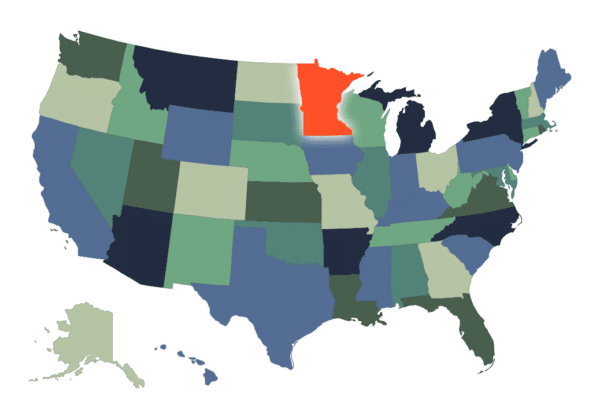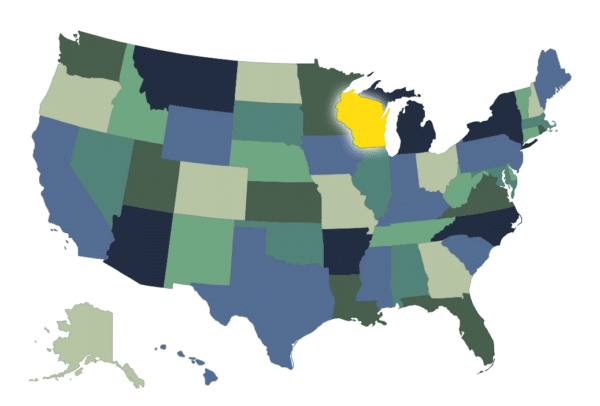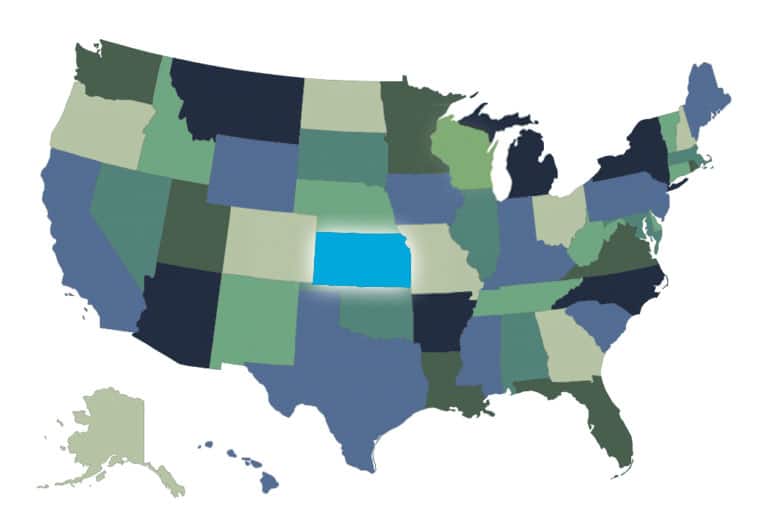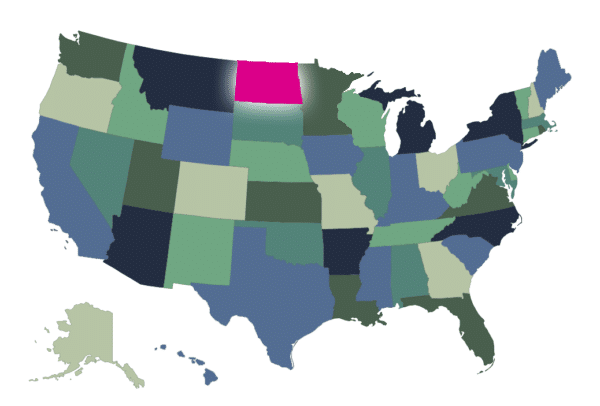
When it comes to figuring out your ideal score on the SAT, there are a lot of numbers to consider. Sectional scores, composite scores, percentiles…how do you know? One way to find out how your SAT scores measure up is by looking at the average SAT scores by state. In this post, we’ll dive into those numbers and examine what SAT scores by state can tell us about college admissions.
These measurements can be particularly helpful if you’re applying to public colleges in-state, as many public universities will compare students’ scores to others from the area. However, average scores in your area can also be important for college admissions in general (no matter where you’re from or where you’re applying), as schools often have admissions officers who focus on particular regions or states.
Here’s the data on SAT scores by state!
What Is the Average SAT Score?
The SAT is calibrated so the average score hovers around 1000. However, despite the many clever people at the College Board (the test-maker), this is hard to achieve in practice. In 2020, the average SAT score for all 2,198,460 students was 1051 (composite), with an Evidence-Based Reading and Writing score of 528 and a Math score of 523.
However, the average score for students who took the SAT essay (1,258,478) was 1081, with an Evidence-Based Reading and Writing score of 541 and a Math score of 540.
Why was the average SAT score for students who took the essay higher? Taking the essay doesn’t give you extra points on these two multiple-choice sections, after all. However, because many competitive colleges require the SAT essay for admission—and some less-competitive institutions don’t—it makes sense that students who take the essay generally prepare more, as they may be aiming for higher scores.
Students who are strong writers also tend to score higher on Evidence-Based Reading and Writing, so there may also be some cause-and-effect in that regard.
SAT Scores by State
We have included the SAT scores by state for all students, regardless of whether they took the essay or not. As you can see from the overall numbers, students taking the essay tended to score slightly higher on average in both sections, so keep this in mind as you evaluate where your scores stand in relationship to others’.
| State | Average Composite (Overall) SAT Scores | Average Evidence-Based Reading and Writing SAT Scores | Average Math SAT Scores |
|---|---|---|---|
| Alabama | 1127 | 576 | 551 |
| Alaska | 1098 | 555 | 543 |
| Arizona | 1139 | 571 | 568 |
| Arkansas | 1157 | 590 | 567 |
| California | 1049 | 527 | 522 |
| Colorado | 1012 | 511 | 501 |
| Connecticut | 1039 | 527 | 512 |
| Delaware | 978 | 497 | 481 |
| District of Columbia | 979 | 498 | 482 |
| Florida | 992 | 512 | 479 |
| Georgia | 1053 | 537 | 516 |
| Hawaii | 1095 | 549 | 546 |
| Idaho | 984 | 500 | 484 |
| Illinois | 1007 | 504 | 503 |
| Indiana | 1074 | 540 | 534 |
| Iowa | 1220 | 611 | 609 |
| Kansas | 1237 | 617 | 620 |
| Kentucky | 1207 | 609 | 598 |
| Louisiana | 1170 | 597 | 573 |
| Maine | 995 | 504 | 491 |
| Maryland | 1029 | 522 | 507 |
| Massachusetts | 1119 | 560 | 559 |
| Michigan | 998 | 503 | 495 |
| Minnesota | 1257 | 624 | 633 |
| Mississippi | 1203 | 610 | 593 |
| Missouri | 1212 | 610 | 603 |
| Montana | 1185 | 598 | 587 |
| Nebraska | 1229 | 615 | 614 |
| Nevada | 1150 | 579 | 571 |
| New Hampshire | 1055 | 531 | 524 |
| New Jersey | 1081 | 541 | 540 |
| New Mexico | 1055 | 533 | 522 |
| New York | 1058 | 528 | 530 |
| North Carolina | 1086 | 533 | 544 |
| North Dakota | 1231 | 615 | 617 |
| Ohio | 1070 | 536 | 534 |
| Oklahoma | 971 | 490 | 481 |
| Oregon | 1104 | 557 | 547 |
| Pennsylvania | 1078 | 543 | 534 |
| Puerto Rico | 993 | 511 | 481 |
| Rhode Island | 990 | 501 | 489 |
| South Carolina | 1026 | 524 | 503 |
| South Dakota | 1218 | 609 | 610 |
| Tennessee | 1186 | 610 | 585 |
| Texas | 1010 | 510 | 500 |
| Utah | 1204 | 601 | 603 |
| Vermont | 1103 | 559 | 545 |
| Virginia | 1116 | 567 | 549 |
| Virgin Islands | 912 | 474 | 437 |
| Washington | 1073 | 539 | 534 |
| West Virginia | 936 | 480 | 456 |
| Wisconsin | 1243 | 615 | 628 |
| Wyoming | 1220 | 614 | 606 |
Which States Have the Highest Average SAT Scores?
The Midwest and Plains States come out strong when it comes to average SAT scores by state. The same four states dominated all categories in 2020. In order, the highest composite scores come from Minnesota, Wisconsin, Kansas, and North Dakota. Highest Evidence-Based Reading and Writing Scores come from Minnesota, Kansas, Wisconsin, and North Dakota. Finally, the highest Math scores come from Minnesota, Wisconsin, Kansas, adn North Dakota. Here’s a closer look at a few of these.
Minnesota Average SAT Scores by State
Minnesota tops the charts with an average composite SAT score of 1257. To put this in context, this is in the top 14% of students taking the SAT—pretty impressive for an entire state!
Minnesota also has the highest average Evidence-Based Reading and Writing SAT scores (624) and the highest Math SAT scores (633) by state.

Wisconsin Average SAT Scores by State
Wisconsin follows close behind Minnesota with an average SAT score of 1243. Average Wisconsin scores for Evidence-Based Reading and Writing SAT were 617 (third highest), and average Math scores 628, coming in second behind Minnesota.

Kansas Average SAT Scores by State
Kansas shot up the list of comparative SAT scores by state in 2020. Kansas students came third in the nation for composite scores, with an average of 1237. In terms of sectional scores, their Evidence-Based Reading and Writing scores came in second at 617, while their average Math scores came in third, with an average of 620.

North Dakota Average SAT Scores by State
North Dakota held its place on the list of top SAT-scoring states this year. In 2020, North Dakota had the fourth-highest composite scores (1231), as well as the fourth-highest Math scores (617). For Evidence-Based Reading and Writing, their score of 615 put them in fourth place nationwide. Pretty impressive!

What Do Average SAT Scores by State Tell Us?
Looking at these SAT scores by state, we can pick out a few common threads. Other than geography (with all four top states in the Midwest and Plains States), what trends do we see?
Interestingly, none of these states requires the SAT for graduation. Instead, Wisconsin requires the ACT for graduation. While this might seem like a contradiction, it actually helps to explain the high SAT scores: all students have to take the ACT, and all schools accept both tests. Therefore, you would only take the SAT if you found the test format easier than the ACT’s. This would lead to higher average scores, as students to whom the test did not come somewhat naturally are less likely to take it.
However, that explanation doesn’t take Minnesota, Kansas, or North Dakota into account. These states don’t require either test. Nevertheless, these states have excellent (and large) public university systems. This is also true of Wisconsin; all five universities were ranked in the top 300 by US News & World Report. This means that students who want affordable tuition at a great in-state college may have to work hard to get their scores as high as possible.
What Average SAT Scores by State Mean for Everyone
Average SAT scores by state are far from the only metric available to measure SAT performance. However, they’re useful for several reasons.
Primarily, average SAT scores by state help contextualize your scores in terms of your state’s school system. How did you do compared to others who had a similar education? (We know that school systems vary significantly within states, but it is one rough measure.)
Once colleges have this knowledge, they can set standards for admission, particularly for public universities with automatic admissions for in-state students with certain scores or with score cut-offs. All colleges reviewing applications can use this information to look at individual students in a wider context, as well.
A Better Way to Put Your Score in Context
What should you do if you need more information about whether you score is “good”? Look at SAT score ideal score on the SAT percentiles. These numbers compare SAT scores to those of all other students who took the test. Particularly if you’re applying to colleges with stiff, nation-wide competition, knowing the broader context of your scores is important.
Also, don’t forget to evaluate the middle 50% of SAT scores for your dream schools. If you’re setting SAT score goals, this is the best place to start!
FAQ
What is an average SAT score 2020?
The average SAT score is currently 1051 overall, with 528 in Evidence-Based Reading and Writing and 523 in Math. For students who took the essay, these scores were 1081, 541, and 540, respectively.
What were previous average SAT scores?
The nationwide average for SAT scores in 2017 was 1060, composite. In 2019, the average was 1059, composite. In 2020, there was a small drop in this, to 1051. By section, average scores were 533/531 (Evidence-Based Reading and Writing, 2017/2019) and 527/528 (Math, 2017/2019). In other words, scores in both sections have gone down slightly. Note that these scores were across all students, not just those who took the essay.
What is an acceptable SAT score?
It 100% depends on where you want to apply. Check out the SAT scores for admitted students at different colleges you might want to attend to get a better sense of what your goal might be.
Is a 1200 on the SAT a good score?
It’s above average, which most people consider “good.” It really depends on where you want to go, as more competitive schools will have pools of applicants with higher scores; it’s best to take a look at the schools you want to attend and evaluate your SAT scores in that context.
A Final Word on Average SAT Scores by State
Learning the average SAT scores by state can help you put your scores (or your student’s scores) in context. However, remember that these average scores are not the be-all-and-end-all of college admissions! In the first place, some states have amazingly high average scores, while others have average scores that fall below the national average. At the end of the day, the best way to evaluate individual scores is by seeing how they measure up to individual goals.
All Magoosh SAT prep plans are digital SAT ready! Start studying today.






Leave a Reply